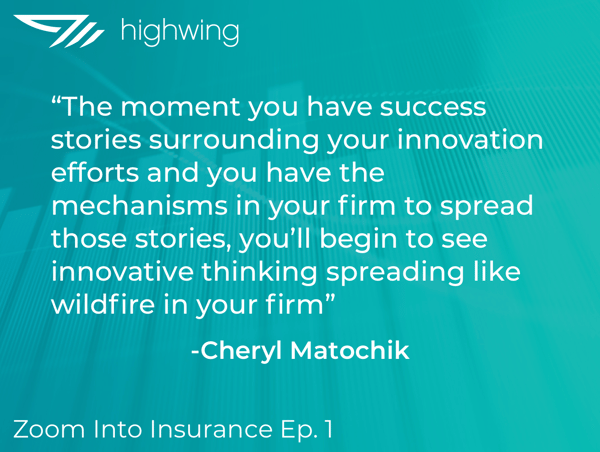How to Prepare your Brokerage for Digital Transformation
Perhaps my favorite thing about working in insurtech is the people I get to work with. As a broker, I don't need to explain it to you; every day we...
4 min read
 Erik Mitisek
:
Sep 2, 2020 1:18:46 PM
Erik Mitisek
:
Sep 2, 2020 1:18:46 PM

If you’ve ever led an innovation initiative, you understand that the hardest part isn’t technology, it’s people. In fact, HBR’s research confirms that the five most commonly cited barriers to corporate innovation are people-related.
That’s why we made the people and organizational barriers to innovation the theme of our first episode of Zoom Into Insurance, a monthly podcast series we launched last month to explore the how-to’s of innovating within commercial insurance with industry and innovation leaders.
Watch or Listen to Zoom Into Insurance
Our first episode featured Cheryl Matochik, Managing Director and Partner at Third Horizon Strategies, and a leading advisor to commercial insurance intermediaries on corporate strategy, technology, and innovation.
Here are the key takeaways
What are the biggest barriers to organizational Innovation?
Internal pushback or turf wars are not as much of an issue in modern brokerages- they know they need to innovate, the biggest issue is a lack of clarity and structure. Your brokerage needs a plug and play model for testing and implementation to lower the lift and timeline for key employees.
How are the most successful brokerages innovating?
The most innovative brokerages start these efforts from the top down, with outcomes looking beyond gains in efficiency, prioritizing innovations that allow the firm to better serve the customer and understand the market in new ways.
Successful innovation depends on mobilizing your workforce to get them excited about innovating. Some firms make massive investments into fenced-in innovation teams, but should instead focus on creating teams with on the ground experience, diversity of perspective, and intimate knowledge of insurance.
Where should a brokerage even start?
Since there are just a few dominant AMS systems, most operational workflows are set. Don't try to make massive sweeping changes right off the bat, start by looking for pressure points in existing processes so you can begin making small moves.
Most agencies should start with looking at marginal changes to existing workflows that can improve client and partner experience instead of going for massive sweeping change. You can think about the value of insurtech in three parts: digitization, market intelligence and market insights. What can we digitize to realize gains in customer experience or efficiency? Once that has been digitized, what intelligence can I gain from that, and how can I now look at market trends to identify further opportunities?
Continue to be mindful of the need to get people at the base of the firm who are involved with clients bought in to your innovation efforts.
How do we operationalize this?
Start top down. Leaders need to talk to the experts and managers within the business to get buy-in and identify pain points. From the onset, understand that these things can take a long time. In Cheryl’s experience, it can take 6-7 months to get the right process in place and 2-3 years for firms to realize substantial ROI.
While innovation initiatives are exciting and inspiring, they can spiral out of control without being intentional and careful. Start small: implementing a point solution that impacts a workflow is the first step to creating a replicable process. Document what went well and refine the process with further implementations until you can take on larger and more complex initiatives.
Think of implementation in these phases

Once you have identified a technology solution or process update you will implement, it is important to take your time with the setup. Agencies need to look at process updates like they do a new product release. You can not have false starts for the initiative to be successful. If you don't do the necessary pre-work and onboard correctly with new tools or processes, you’ll be stuck in a place where you have a sour first experience and don’t get utilization.
Onboarding needs to go from top down, making everything crystal clear to your stakeholders how to use a new process or technology, why they are using it, and how to talk about it to clients.
Here’s another reminder to not try to reinvent the wheel right off the bat. You have a well functioning business, so don’t roll out a new system in a way that could impede your business. Start with one department, or client and document feedback and results as you go. This feedback will inform iterations on the system that allow you to operationalize it.
Once your limited rollout has smoothed out, you can begin to look to other areas where you can apply the new system. Documentation and communication makes this phase easier. If the whole firm is excited about the efforts to innovate and are kept up to date on the progress, people within your firm will begin to identify the opportunity areas for scaling a new system as it relates to their jobs.
Keeping tabs on feedback, testing, metrics and progress with new innovation efforts is key to refining your process, identifying new opportunity areas and scaling innovation through your organization. Track what went well and refine the process until you can take on larger and more complex initiatives.
The moment you have success stories surrounding your innovation efforts and you have the mechanisms in your firm to spread those stories, that's where you really begin to see innovative thinking spreading like wildfire in your firm. As you document these projects and findings, you very well may find other parts of the organization can pull on this experience and apply it to their own projects. Not only does this create a more innovative and empowered team, but it builds excitement and confidence.
Tips for the road: getting started and sustaining innovation.
Want to learn more? You can listen to the full interview here.

Perhaps my favorite thing about working in insurtech is the people I get to work with. As a broker, I don't need to explain it to you; every day we...

Many insurance leaders view innovation as an imperative, but don’t know how or where to start. Lacking goals and direction, they keep putting...

Part 1 of 2: What it is and why you need one to guide innovation.